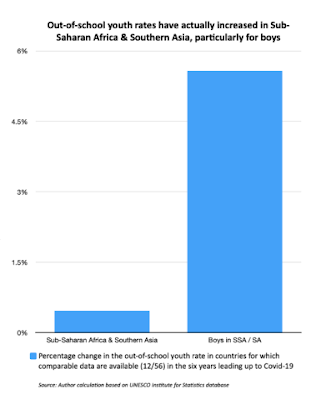Remember About The Individuals Who Were Not In School Before The Pandemic
By Andrew Christensen, Dr Carla Pezzulo
, Professor Andy Tatem , Dr Victor Alegana and Omar Bakari, academics and
practitioners working in education policy, disability rights, public health,
and geospatial and data science
School terminations
during the pandemic have influenced many millions. However, the out-of-school
emergency extended path before the infection, and it might keep going long
after it, except if we ponder school access.
Prior to the
infection, there had been a virtual halt on out-of-school youth rates for just
about 10 years, and the world was at that point because of miss the mark
concerning its general optional school focus by 2030.
The sheer size and industriousness of out-of-school rates proposes that we were at that point missing something major before the appearance of COVID-19. Appraisals recommend that 199 million young people of auxiliary young (around 12 to 17 years of age) were at that point out of school pre-pandemic, and that, appallingly, the extent of the optional young populace that was out of school had barely gone down since 2012.
Auxiliary training
changes lives, wellbeing, and occupations, yet approaches appear to be coming
up short. Building more blocks and mortar and presenting expense free tutoring
were the beginning of the excursion, however the excess miles to accomplishing
widespread auxiliary will require considerably more subtlety in handling the
geographic variety and less apparent boundaries to get to.
Strategies come up
short. The SDGs incorporate widespread optional instruction, yet this is almost
missing from the country plans which were broke down in the Global Education
Monitoring Report, Beyond Commitments, delivered not long before the pandemic.
Optional age out-of-school youth establish around 77% of out-of-younger
students, however just 19% of instruction help is spent on auxiliary training.
Strategy is missing extent and need.
Difficulties for all
inclusive auxiliary access contrast from essential to a significant degree, and
approaches ought to be custom fitted as needs be. Gendered standards have high
results in puberty: kid bearing and work market passage contend with school
participation and change life directions. Expenses of optional tutoring to
families are more noteworthy, hindrances to section are higher (for example
placement tests, deficient sterilization offices for feminine cleanliness the
executives), conduct is more hard to impact, and there is likewise a pervasive insight
that after essential closures, training is 'finished'.
Strategy needs to
consider ages to come, yet not disregard the age that is available. Interest in
fundamental acquiring abilities should traverse essential, yet in addition
auxiliary age gatherings, particularly when three of four of the individuals
who are out of school are youngsters. Surveys propose strategy ought not just
underline holding in danger youth in school, yet in addition think about
remediation through formal or elective training (for example additional
opportunity, equivalency projects) and combination with the work market.
To meet the extent of
the test, we need to follow inside nations, not simply between them.
Out-of-school numbers and their causes vary from one spot to another and
between bunches inside nations, however strategy ordinarily doesn't. Strategy
should think about topography: in the initial twenty years of this century,
geographic divergence in instructive fulfillment really expanded inside certain
nations. Novel geospatial research has gained ground (see GRID3 and
IIEP-UNESCO) and multivariate demonstrating makes advances, however numerous
techniques have not been applied to the degree they need to with the end goal
for policymakers to handle the emergency with more prominent geographic and
interconnected subtlety.
Arriving at all
inclusive optional schooling requires strategy that records for the regularly
covered up and complex hindrances looked by changed gatherings. Hindrances
contrast between gatherings (for example across sex, incapacity, identity) and
those hindrances influence youth in various, regularly compounding, ways.
Secret expenses for families are predestined work market openings, however the
cost of outfits, school supplies, shoes, and 'deliberate' – yet casually
required – parental charges. Perspectives block access, through sexual
orientation norming of young ladies, yet additionally through negative
generalizing of youth with handicaps. Strategy can do more to represent these
unobtrusive contrasts, and the advantages of doing so would be enormous.
Accomplishing all
inclusive admittance to auxiliary instruction would twist world history. Take
Sub-Saharan Africa alone: this area will represent the greater part of the
development of the total populace throughout the next few decades, and numerous
evaluations propose that by 2050, it will have more youth than some other
district on the planet. Segment changes like this can yield enormous profits,
and training is important to open those profits.
Optional training
changes lives: we know this from a common freedoms viewpoint, yet it is
likewise borne out exactly. Instruction improves wellbeing, and evaluations
propose private financial re-visitations of schooling are high internationally,
and most noteworthy for the two young ladies and young men in Sub-Saharan
Africa, especially for auxiliary training.
The combined impact of
all inclusive optional will be huge, however we need enormous change to arrive
– the numbers, even before Covid-19, propose that arriving at general access
requires a shift in direction: we not just need spending plans that represent
the sheer extent of the emergency, yet we likewise need strategy that handles
geographic and sexual orientation imbalance, and uniqueness because of
inability.
This is certainly not
a simple inquire. In any case, as children head back to class after Covid-19,
let us not disregard the individuals who were out of school in any case.




0 Comments